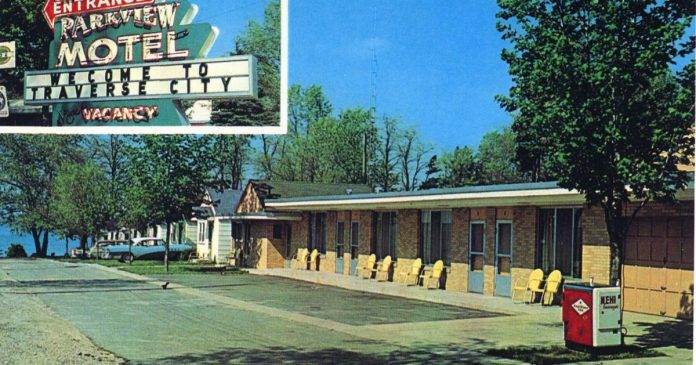TRAVERSE CITY — Peak travel season continues in northern Michigan. The tourist economy is booming.
Modern-day visitors arriving by car sweep into town on paved highways and luxuriate in bayshore hotels. This is a far cry from the rutted roads and rustic lodgings that welcomed the first wave of “auto tourists” around 1910.
The changes in between those dates were particularly vital for the Traverse City area.
By 1910 the lumber boom was over, and jobs were disappearing. Luckily, Americans were just beginning their love affair with the automobile. Encouraging more and more people to drive north along the beauty of the Lake Michigan shoreline helped the area thrive.
So how did Traverse City, and for that matter all of America, go from the travel of 1910 to what it experiences today?
Start by imagining visitors traveling north from Chicago in 1913. Then compare that experience to the same trip in 1940, and then in the mid-1960s.
In 1913, hardy motorists, likely driving a Model T Ford, traveled on dirt roads that hadn’t changed much since the 1880s. That Ford would spend much of its time sunk up to its hubcaps in either mud or sand, depending on the weather.
And its occupants would spend a lot of time digging it out. This was one reason why early motorists often did not stay at already established hotels in towns along their route. It was just impossible to get from one place to the next in one day. And in 1913 in-town accommodations did not have parking lots.
Also, many such hotels were quite upscale. In 1913 Traverse City’s Park Place Hotel was still a three-story, clapboard institution boasting an expansive first-floor veranda. Owners and guests of such businesses often frowned upon groups of mud-caked auto enthusiasts dirtying up their lobbies. So many early motorists simply pitched a tent next to their vehicle as night fell.
Such motorists were a hardy bunch, for whom these challenges were probably part of the lure of travel. But state government officials, local boosters and private entrepreneurs came to an important realization: To build a booming tourist economy they had to appeal to a much larger demographic. Significant improvements had to be made both to motorists’ lodging choices and to the roads on which they traveled.
So in 1919 Michigan created its state park system. It was a move based, in part, on the need for motorists to have comfortable places to camp. The Traverse City area claims two very early parks.
The state purchased Interlochen Park in 1917, and then folded it into the new system in 1919. Traverse City State Park opened in 1920, in the same year as several other early locations.
Private business also rose to the occasion. Across the country entrepreneurs began offering “camps” with rustic, box-like cabins sitting side by side along the road. They weren’t much but staying in them was less work than pitching one’s own tent.
As demand for lodging increased, competition led to further improvements. Roadside cottages started to boast flower boxes outside, and indoor plumbing inside. By the mid-1930s cabins were being organized into motor courts, often built in U-shaped designs. Land was becoming too valuable to have cabins strung out along the road.
As lodging improved, so did roads. The West Michigan Pike Association formed in 1912 , its purpose to see a continuous hard-surface road stretching from New Buffalo to Mackinaw City. That goal was achieved by the mid-1920s, and the resulting highway went right through Traverse City.
So, for 1940, imagine cruising north from Chicago in a Chevrolet DeLuxe, the year’s best-selling vehicle. The road, in 1926 renamed US Highway 31, is smooth and the scenery outstanding.
Once in Traverse City, tourists had numerous motor courts from which to choose. Several were strung along East Front Street, including the “Whispering Pines,” at 867, the “Travel-O-Tel “ gracing 731, and the “Sunset Log Cabins” at the corner of Munson Avenue and Fair streets. Others were scattered throughout the city.
Skip ahead to the 1960s, and things again had changed. During World War II supplies had been hard to find, and motor court design underwent a significant change.
Individual cabins began to die out in favor of more economical inline rooms sharing one foundation along with plumbing and electrical systems.
Many “slightly older” people will well-remember traveling across country and pulling up to one of these low-slung buildings. After a long day’s trip, travelers could back right up to the door of their room and unload their cars. No luggage carts, bell boys or elevators needed! When possible, many 20th-century tourists still choose this simpler style of lodging.
Chicago travelers of the ‘60s could still cruise north on US 31, perhaps driving that year’s most-purchased vehicle, a Chevrolet Impala. Or they might choose to motor on the relatively new federal interstates crisscrossing Michigan: I-94, I-96 and 1-75. Started in the mid-1950s, the interstate system would eventually have a major impact on the lodging industry.
But in the ‘60s that change hadn’t yet gained momentum.
Once in Traverse City, lodging choices abounded, including many of those drive-up motels. Tourists could have stayed at the Terrace Beach Motel, 841 E. Front, or have gone a bit “retro,” and overnighted next door at the Island View Cottages, 853 E. Front. Today both businesses still stand.
Or perhaps visitors would choose the Parkview Motel at 825 E. Front. That spot on the bay first hosted tourist cabins, then the Parkview, and today sports the Bayshore Resort.
By 1966 even the iconic Park Place had jumped on the motoring band wagon. By then a multi-story brick hotel, a new owner rechristened it the Park Place Motor Inn. Perhaps in another nod to the “auto tourist,” he also doubled the number of parking spaces.
Today drivers can still enjoy an “auto tour.” Take a slow drive around town and discover the surviving tourist cabins and motels. Look around, and what you see may take you on a gentle journey into the past.













